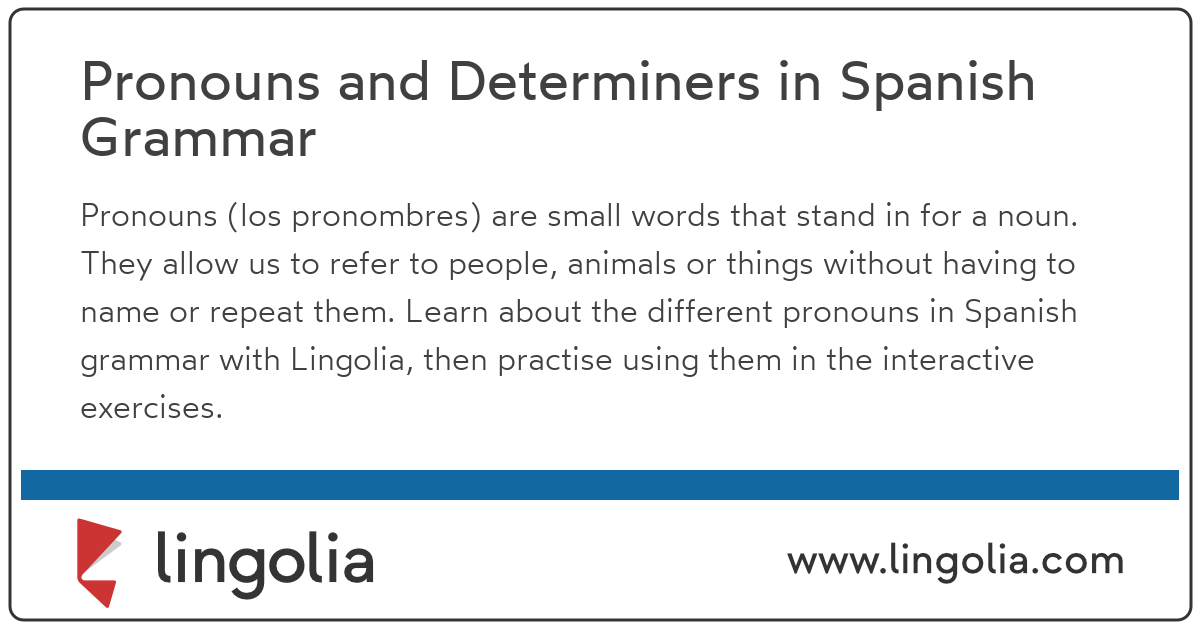
Using Spanish possessive pronouns in sentences Spanish possessive pronouns are normally used after the irregular verb SER and sometimes directly after definite articles el la los. Los pronombres posesivos Spanish possessive pronouns are used to replace a noun or noun phrase previously mentioned.

Except when followed by forms of ser a verb meaning to be the possessive pronouns are preceded by el la lo los or las.
How to use possessive pronouns in spanish. A Spanish possessive pronoun pronombre posesivo such as mío or suyo is used in place of a noun and a possessive adjective. Each Spanish possessive pronoun has four forms that must agree in gender masculine or feminine and number singular or plural with the noun in the phrase they replace. These pronouns are the same as the long forms of.
Possessive Pronouns in Spanish Possessive adjectives replace the article and go before the word being described as in tomo de mi vaso I drink from. Possessive pronouns replace the word as in tomo del mío I drink from mine. The rule of thumb to remember is that possessive pronouns in Spanish must match the nouns they represent in both number and gender much like adjectives do.
They dont have to match the number or gender of the person or thing who possesses the subject of the sentence. A quick lesson on using possessive prounous in Spanish. About Press Copyright Contact us Creators Advertise Developers Terms Privacy Policy Safety How YouTube works Test new.
The possessive pronouns of Spanish take the same form as the long form of the possessive adjectives namely mío tuyo suyo nuestro and vuestro along with their plural and feminine counterparts. Except when followed by forms of ser a verb meaning to be the possessive pronouns are preceded by el la lo los or las. Using Spanish possessive pronouns in sentences Spanish possessive pronouns are normally used after the irregular verb SER and sometimes directly after definite articles el la los.
An easy way to remember these pronouns is by memorizing the ones in singular masculine form in the chart above such as MÍO TUYO and so on. Possessive Pronouns in Spanish. Mine El mío La mía Los míos Las mías.
Yours informal El tuyo La tuya Los tuyos Las tuyas. Httpsbitly34U5ljY Click here to access our Absolute Beginner Course for free and download your 52-page PDF Guide to learn Spanish from Home. In this v.
Possessive pronouns can also be used with the definite articles ellaloslas. To revise this see. How to say mine yours his hers its ours and theirs possessive pronouns How to say ours and yours plural possessive pronouns Want to make sure your Spanish sounds confident.
Well map your knowledge and give you free lessons to focus on your gaps and mistakes. Start your Braimap today. When How to Use Possessive Pronouns in Spanish.
In Spanish all pronouns have a main purpose. On top of this main function Spanish possessive pronouns are also used to express possession. When using possessive pronouns.
In this lesson Danny introduces Possessive Pronouns. These pronouns are my our your his her its and their. Theres also an independent.
These pronouns are my our your his her. A possessive adjective shows us to whom the noun belongs. A possessive pronoun is used in place of a noun and a possessive adjective.
And while possessive pronouns are the equivalent of hisheryourstheirsmineits in English they are not used exactly in. Possessive Pronouns indicate possession or belonging making a reference to the owner and the object possessedFor a full lesson on this topic visithttpw. The Spanish possessive pronouns are as follows.
Mío mía míos mías mine tuyo tuya tuyos tuyas yoursinformal singular suyo suya suyos suyas his hers theirs yoursformal singular and plural. Los pronombres posesivos Spanish possessive pronouns are used to replace a noun or noun phrase previously mentioned. For this reason they always agree in gender and number with the possessed entity never the possessor like in English and never go before the noun.
In Spanish possessive adjectives are normally not used when talking about body parts. Theyre also often not used when talking about abstract concepts or something that it is obvious that only the speaker could possess. Instead youll see a definite article used in Spanish though in English translations a possessive adjective may be used.
The video includes many examples of sentences and the basic transformations that possessive pronouns undergo to agree with nouns and other words in sentences. Main Lesson in Spanish.